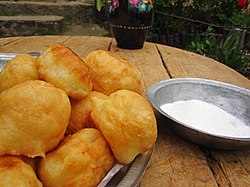Zalabiyeh
 Deep-fried zalabiyeh | |
| Alternative names | Spongy dough (sufgan), zlebia, jalebie, zülbiya, jilapi |
|---|---|
| Type | Fritter, Doughnut |
| Region or state | Near East, Yemen, North Africa, Egypt, Israel |
| Main ingredients | Batter (flour, yeast, water, salt), Optional: eggs, milk, sesame oil, sesame seeds[1]) |
Zalabiyeh (Arabic: زلابية) is a fritter or doughnut found in several cuisines across the Middle East and West Asia. The fritter version, similar to jalebi and funnel cake, is made from a semi-thin batter of wheat flour which is poured into hot oil and deep-fried.[2] The earliest known recipe for the dish comes from a 10th-century Arabic cookbook and is made by pouring the batter through a coconut shell. Zalabiyeh is also the Arabic language term used by Mizrahi Jews for a deep-fried yeast dough, often topped with either honey or syrup, and known as burmuelos in Ladino.[3]
History[]
The earliest known recipes for zalabiya comes from the 10th century Arabic cookbook Kitab al-Tabikh.[4][5] In the ancient Baghdadi recipe, the dough was poured through a coconut shell. This style of fritter is similar to the Indian jelabi and a 16th-century recipe from German cuisine for strauben made using a funnel.[6]
Among Yemenite Jews, the zalabiyeh was a treat eaten especially during the winter months.[7] In Yemen, the zalabiyeh was fried in a soapstone pot lined with oil about 1 cm. deep, in which oil and sometimes honey was mixed.[8]
Customs[]
Zalabiyeh are commonly eaten by Muslims during the month of Ramadan, and during the Diwali celebrations for Hindus and Christian communities during Advent and Easter, and by Sephardic Jews for Hanukkah.
Hanukkah traditions[]
According to 2 Samuel 13:8–10 King David's daughter prepared fritters (Hebrew: לְבִיבוֹת) for her step-brother Amnon.[9][8] By the 2nd-century CE, the name of the fritter had taken on the name sūfğenīn (Hebrew: סוּפְגְּנִין) in Mishnaic Hebrew, a word derived from its sponge-like texture with alveolar holes.[10][11][12]
Zalabiyeh (or zelebi) are a traditional sufgan ("spongy dough") for Persian Jews.[4]
Modern variations[]
The fritter is very common in the Indian subcontinent, in countries such as India, Pakistan, Sri Lanka, Nepal, Bangladesh, although made differently to that of the Middle Eastern and North African variety. In many Middle Eastern and North African countries, such as Iran, Iraq, Jordan, Syria, Lebanon, Tunisia, Algeria, Egypt and also in Israel, they resemble spongy-cakes fried in oil.[citation needed]
In Iran, where it is known as zolbiya, the sweet was traditionally given to the poor during Ramadan. There are several 13th century recipes of the sweet, the most accepted being mentioned in a cookbook by Muhammad bin Hasan al-Baghdadi.[13]
In Iraq in the 20th-century, starch (Arabic: النشا) was a basic ingredient in their zalabiyeh, topped with sugar.[14] In North Africa, zalabiyeh was often made with yoghurt added to the dry ingredients.
They are known as zlebia in Tunisian cuisine, jalebie in the Philippines, zülbiya in Azerbaijan and jilapi in India.[15]
See also[]
References[]
- ^ Brauer, E. (1934). Ethnologie der jemenitischen Juden (Ethnology of Yemenite Jews) (in German). Heidelberg: Carl Winters Universitätsbuchhandlung. p. 100. OCLC 299777900.
- ^ Hunwick, Heather Delancey. Doughnut: A Global History.
- ^ Savoring Gotham: A Food Lover's Companion to New York City. Oxford University Press.
- ^ Jump up to: a b Goldstein, Darra. The Oxford Companion to Sugar and Sweets. Oxford University Press.
- ^ al-Warraq, Ibn Sayyar; Nasrallah, Nawal (Nov 26, 2007). annals of the caliphs' kitchens. BRILL. p. 413 chapter 100. ISBN 978-9004158672.
- ^ Goldstein, Darra (2012). The Oxford Companion to Sugar and Sweets. Oxford University Press.
- ^ Mizrachi, Avshalom (2018), "The Yemenite Cuisine", in Rachel Yedid; Danny Bar-Maoz (eds.), Ascending the Palm Tree: An Anthology of the Yemenite Jewish Heritage, Rehovot: E'ele BeTamar, p. 132, OCLC 1041776317
- ^ Jump up to: a b Qafih, Y. (1982). Halichot Teman (Jewish Life in Sanà) (in Hebrew). Jerusalem: Ben-Zvi Institute. p. 209. ISBN 965-17-0137-4. OCLC 863513860.
- ^ Cf. David Kimhi, Commentary on 2 Samuel 13:8, who wrote: "...according to our Sages, of blessed memory, she made for him varieties of fried pastry, which is when they fry the dough in a frying pan containing oil." This same opinion is held by Levi ben Gershon, ibid, and by Rashi (ibid.) who adds that the fine flour used to make the dough was first scalded in hot water before being fried in oil.
- ^ Nathan ben Abraham (1955), "Perush Shishah Sidrei Mishnah - A Commentary on the Six Orders of the Mishnah", in Sachs, Mordecai Yehudah Leib (ed.), The Six Orders of the Mishnah: with the Commentaries of the Rishonim (in Hebrew), 1, Jerusalem: El ha-Meqorot, OCLC 233403923, s.v. Hallah 1:5 (sūfğenīn, al-zalābiye)
- ^ Hai Gaon (1921), "Hai Gaon's Commentary on Seder Taharot", in Epstein, J.N. (ed.), The Geonic Commentary on Seder Taharot - Attributed to Rabbi Hai Gaon (in Hebrew), 1, Berlin: Itzkowski, OCLC 13977130 (Available online, at HebrewBooks.org: The Geonic Commentary on Seder Taharot - vol. 1), s.v. Keilim 5:1 (p. 15)
- ^ Cf. Mishnah (Hallah 1:5 (p. 83))
- ^ Alan Davidson (21 August 2014). The Oxford Companion to Food. Oxford University Press. pp. 424–425. ISBN 978-0-19-967733-7.
- ^ Yosef Hayyim (1986). Sefer Ben Ish Hai (Halachot) (in Hebrew). Jerusalem: Mercaz ha-sefer. p. 218 (First Year). OCLC 64088621.
- ^ Jones, Paul Anthony (2019). The Cabinet of Linguistic Curiosities: A Yearbook of Forgotten Words. University of Chicago Press.
- Arab cuisine
- Yemeni cuisine
- Iraqi cuisine
- Middle Eastern cuisine
- Tunisian cuisine
- Azerbaijani cuisine
- Indian cuisine
- Fritters
- Hanukkah foods
- Doughnuts
- Mizrahi Jewish cuisine